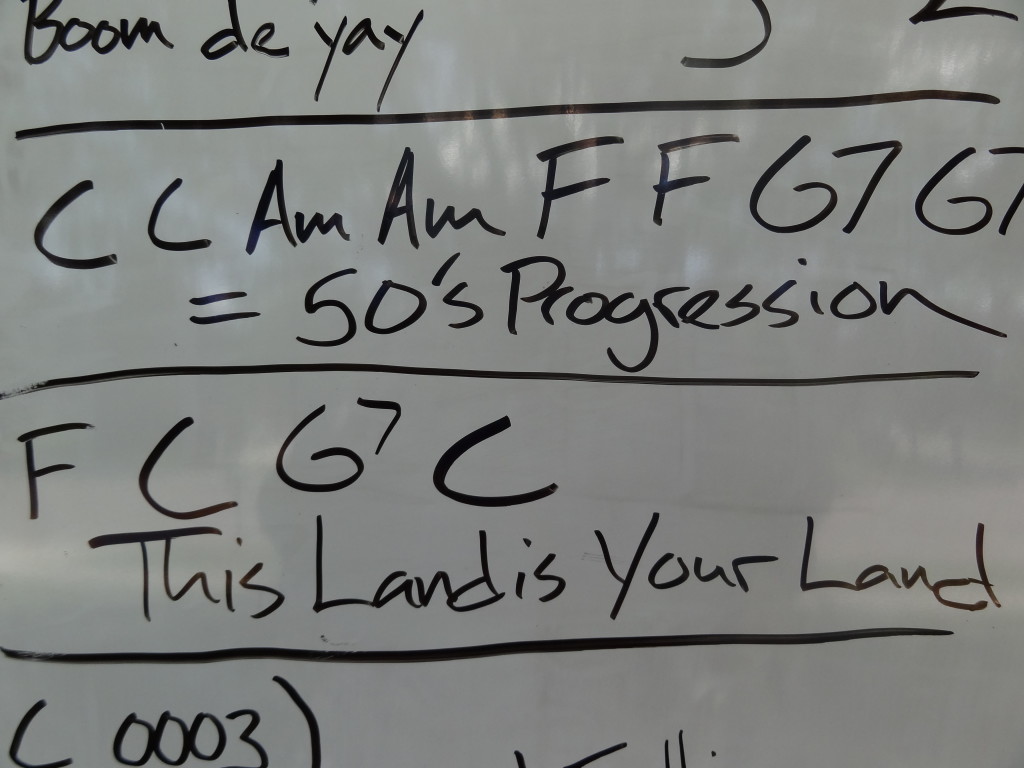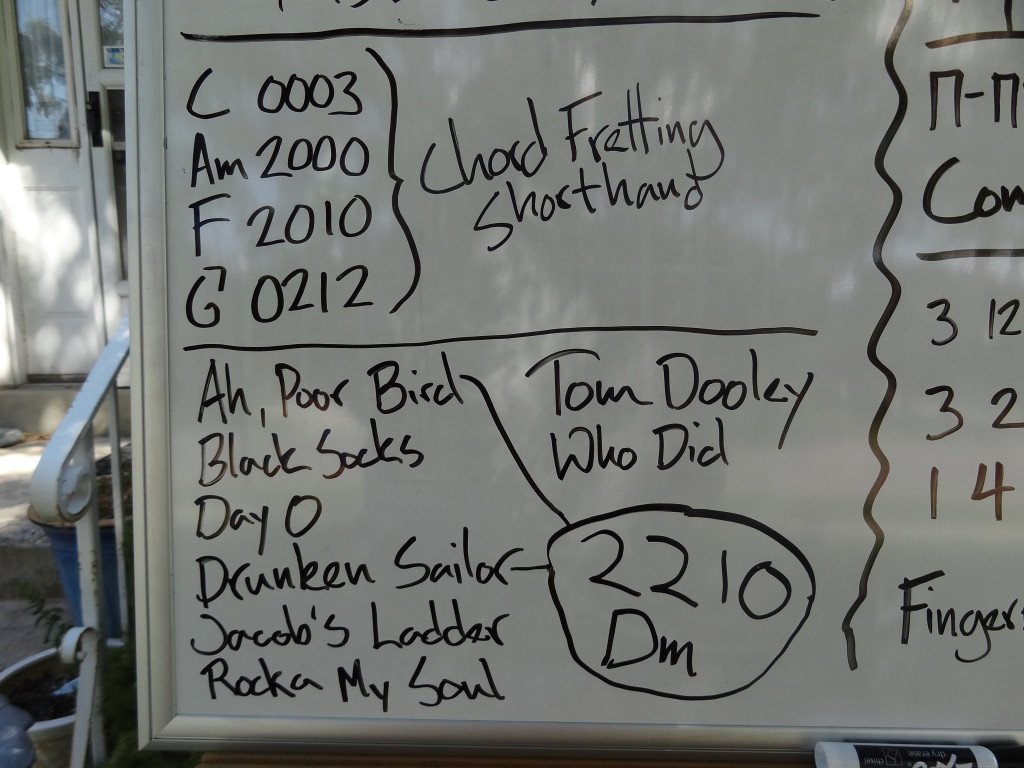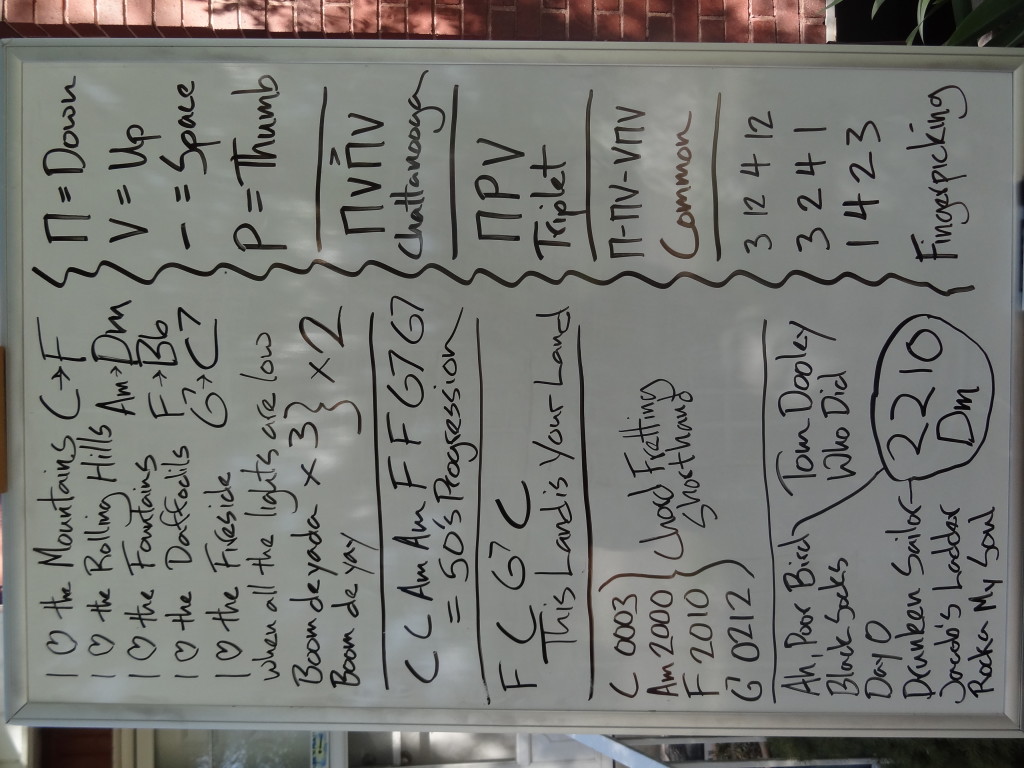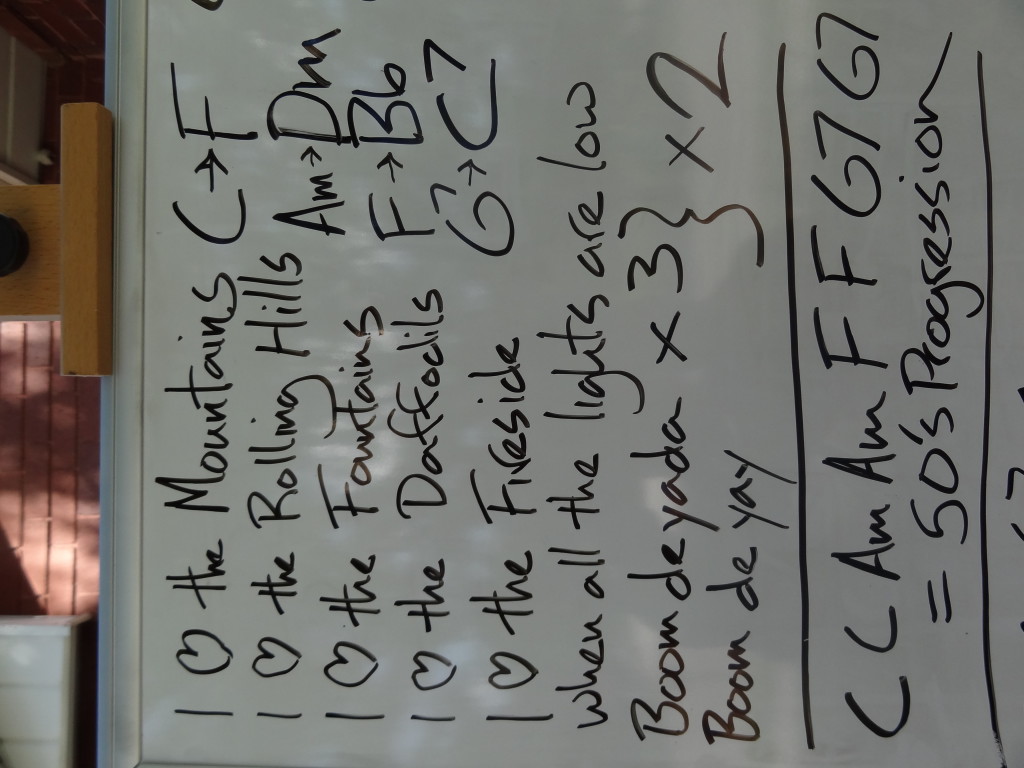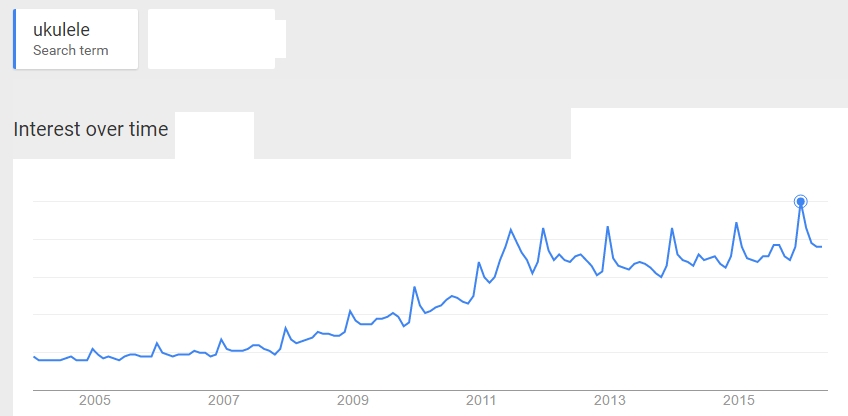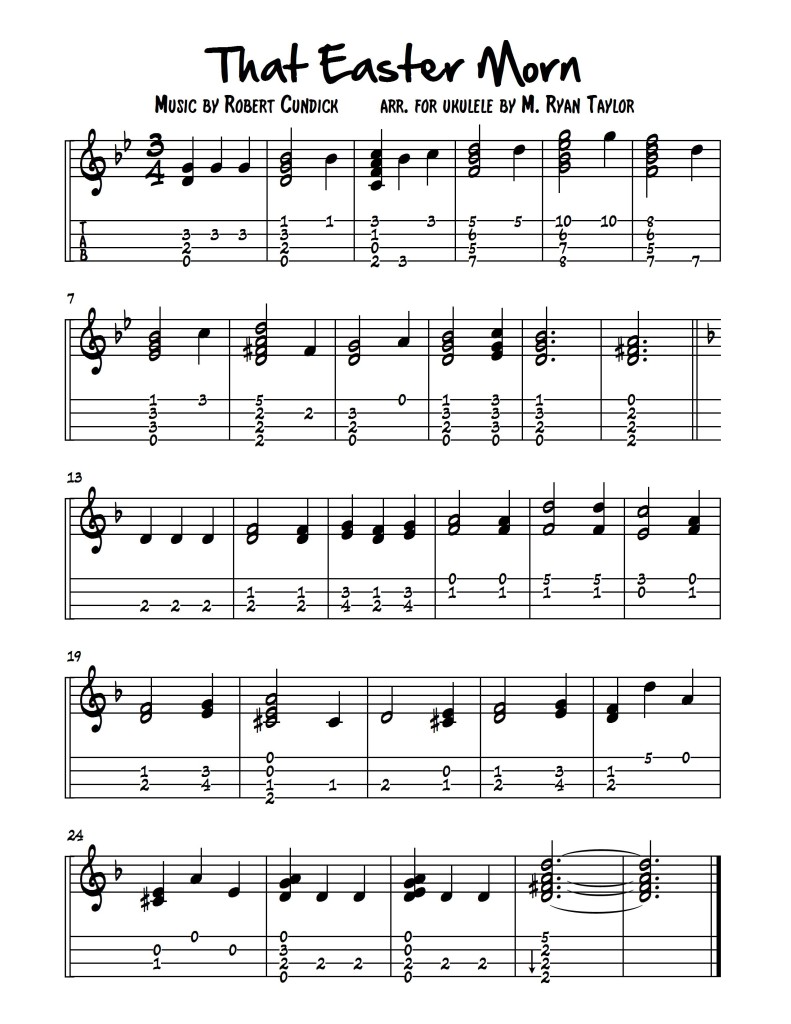The Beauties of a Lyric Sheet w/Chords : Ex. What a Wonderful World
As someone that grew up in a very ‘classical’ family (meaning my dad was a band director and we had lots of traditional sheet music available to us all the time, piano lessons from an early age and the expectation that we would choose an additional instrument well before entering high school), winning me over to the beauties of a simple lyric sheet with chords took quite a long time. I still believe traditional notation is important and it would be great if everyone learned how to ‘read’ music, as it is such a big part of our lives, but a lyric sheet with chords also has some distinct advantages:
- If you already know a melody, there’s really no point of having it notated if it is already in your brain.
- Lyric/chord sheets are easy to create/edit in a simple word processor or even on a sheet of paper, allowing you to make quick changes to reflect your interpretation of the song.
- May eliminate page turns.
- Simplifying the bare bones ‘lead sheet’ (that has a melody notated in addition to lyrics and chords) may help facilitate memorization for singers who are accompanying themselves (like myself).
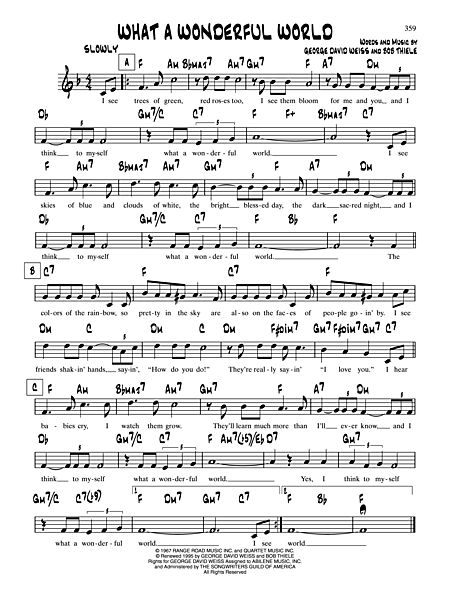 On this last point, take a moment to look at a traditional lead sheet of What a Wonderful World from Sheet Music Plus. There are THREE lines of information here:
On this last point, take a moment to look at a traditional lead sheet of What a Wonderful World from Sheet Music Plus. There are THREE lines of information here:
- The lyrics
- The melody above the lyrics
- The chords above the melody
This is awesome if you don’t know the song, because you can learn a basic sketch of it from this information. However, it is lousy at forming a mental picture of the song in your mind because you’re trying to deal with 3 separate lines of info (trying to read left/right and up/down at the same time). By getting rid of the melody (which hopefully, we already know) and condensing the chords and lyrics of the song to a single line, we make it easier to memorize the chord patterns in the song. For example, as you look at the first lines of each of the verses of this song, the chord pattern and the one place it deviates (an A7* before the third verse) become really obvious and easy to commit to memory:
What A Wonderful World
By George David Weiss and Bob Thiele
I see [D]trees of [F#m]green, [G]red roses [F#m]too
[Em7] I see them [D]bloom for [F#7]me and for [Bm7]you
And I [Bb]think to myself [Em7] what a [A7]wonderful [D]world [Bm7] [Gmaj7] [A7]
I see [D]skies of [F#m]blue and [G]clouds of [F#m]white
[Em7] The bright blessed [D]day, and the [F#7]dark sacred [Bm7]night
And I [Bb]think to myself [Em7] what a [A7]wonderful [D]world [G] [G] [D]
The [A7]colors of the rainbow so [D]pretty in the sky
Are [A7]also on the faces of [D]people going by
I see [Bm7]friends shaking [F#m]hands saying [Bm7]how do you [F#m]do
[Em7]They’re really [F#dim7]saying [Em7]I [F#dim7]love [Em7]you
[A7]I hear [D]babies [F#m]cry, [G] I watch them [F#m]grow
[Em7] They’ll learn much [D]more than [F#7]I’ll ever [Bm7]know
And I [Bb]think to myself [Em7] what a [A7]wonderful [D]world [Fdim 2020] [B7]
Yes I [Em7]think to myself [A7] what a [C#dim7]wonderful [D]world [G6] [Gm6] [D]
In this version, I was also able to quickly fix errors the original transcriber made in both lyrics and chords, change the key, substitute some jazzier chords, and note that an Fdim (without a 7) is fingered 2020 on the ukulele fretboard.
That said, traditional lead sheets and full scores still play an important role in musical learning, so don’t throw the baby out with the bathwater. 🙂
*Of course, another way of looking at the A7 is that it really belongs to the end of the bridge section, in which case it should be moved to the end of ‘I love you’ in the previous line. If you think of it this way, all three first lines of the verses have an identical pattern.
More Music for Ukulele Ensembles! Blackbird, Over the Rainbow & More.
I just finished a round of arranging songs for UFO HUM‘s next concert; these 100% legal arrangements for ukulele ensembles (royalties make their way back to the copyright holders) are available through a special arrangement with Sheet Music Plus. Here are the new titles:
- The Bare Necessities (from Disney’s The Jungle Book)
- Blackbird (The Beatles)
- Don’t Worry, Be Happy (Bobby McFerrin)
- Lean on Me
- Over the Rainbow (from The Wizard of OZ)
- Viva La Vida (Coldplay)
- You’re Never Fully Dressed Without a Smile (from Annie)
You can check out more titles released before Christmas on the For Ukulele Ensembles page of this site.
New Music for Ukulele Ensembles plus Freebies
I’ve created a new page, For Ukulele Ensembles, with music I’ve arranged for 3 or more ukulele players. The page currently contains a couple of BLACK FRIDAY FREEBIES (Canon in C, and I’ll Fly Away), as well as a number of popular Christmas songs (Feliz Navidad, It’s Beginning To Look Like Christmas, The Little Drummer Boy, Sleigh Ride, Silver Bells, You’re a Mean One, Mr. Grinch).
I’ll be adding arrangements of Best Day of My Life : American Authors, Music of the Night : Andrew Lloyd Webber, Happy : Pharrell Williams and more in 2017!
Unlike a lot you find on the internet, these are 100% legal arrangements (royalties make their way back to the copyright holders) through an agreement with SMP Press who works with Hal Leornard music publishing.
I hope you enjoy these with your own ukulele trios, ensembles, bands and orchestras. Happy Holidays!
First Melodies for Ukulele : Free eBook
- First Melodies for Ukulele : 18 familiar tunes to help folk get started with tablature. Includes tablature and staff notation so you can get to know the notes on your fretboard better at the same time.
I put this together for my beginning ukulele students, but thought others might benefit as well. Enjoy!
Christmas is Coming!
Get more ukulele books for your friends and loved ones this holiday season . . .
- NEW! The 2-Chord Christmas Songbook : EASY UKULELE TAB EDITION
- Top 25 Celtic Session Tunes for Ukulele : Popular Tunes in Tab & Notation
- The Ultimate Dictionary of Strum Patterns : for Ukulele Nerds Only
- Titan M’s 2 Chord Companion : 157 songs in Ukulele-Friendly Keys
- Christmas Carols for Ukulele Orchestra : 12 Classic Carols
- The Haunted Ukulele : 59 Spooky Songs to Cast a Spell on Your Audience
- Christmas on 34th Street : 34 3-4 Chord Christmas Classics for Ukulele
- Two Chord Camp Songs for Ukulele : 32 Silly, Funny, Crazy Songs
- The Two Chord Christmas Songbook : 34 Lesser-known Christmas Gems
I <3 the Mountains - Whiteboard
Today my weekly Two Trees ukulele youth class went over the classic camp song, I Love the Mountains. The repeating chord pattern is a great one for beginners. We also talked about transposition and bringing the song up from the key of C (which is easy, but I find a little low for my voice) to the key of F. I took some shots of the white board and thought I’d pass them along.
Note that some versions of the song use the pattern C-C-Am-Am-Dm-Dm-G7-G7 instead of C-C-Am-Am-F-F-G7-G7. This would translate in the key of F to F-F-Dm-Dm-Gm-Gm-C7-C7 instead of F-F-Dm-Dm-Bb-Bb-C7-C7 and as Gm is easier than Bb for beginners it might be the way to go.
Annual Ukulele Popularity Cycle
This is mainly a bit of random trivia, but if I asked you what month of the year is the ukulele most popular, wouldn’t you choose a Summer month? Would you believe that if you use Google Trends to track the term ukulele (click for detailed data) that you’d find that December is consistently, year after year, the time when people are searching for info on ukuleles? Could it be this is just when people are searching for ukuleles as gifts for Christmas? or is it possible that people need a little ukulele time in the dead of winter? I’d probably go with the Christmas theory.
The next most popular time of year for the ukulele is the Summer months (which seems to make sense to me) with the Fall dipping to the low point for the year (perhaps because folks are busy with the business of getting back to school?).
Anyway, I just found this regular pattern (it almost looks like a musical waveform) so interesting that I felt inspired to share. I’d love to hear what other people think of the pattern; please feel free to propose your theories in the comments section below.
Also, anyone hazard a guess as to what caused that uncharactaristic spike in June of 2011 that disrupts the regular pattern?
Overcoming Sheet Music Addiction
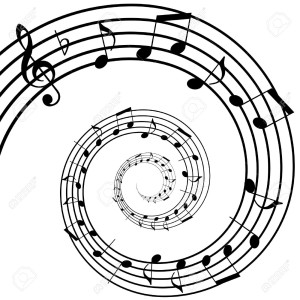 or Confessions of a Sheet Music Addict
or Confessions of a Sheet Music Addict
The last few weeks have been pretty important for me in overcoming one of my SECRET FEARS . . . performing WITHOUT sheet music.
I know it doesn’t sound that frightening or serious, but its a big deal to me. I did my undergraduate degree in vocal performance, so I’m no stranger to performing memorized songs where someone else is accompanying (I memorized whole opera roles for heaven’s sake). However, adding that extra layer of accompaniment, strumming and fingerpicking on my not-very-simple homespun ukulele songs (I did my graduate degree in composition and its not uncommon for me to use a dozen different chords in a song) has been truly terrifying and has stopped me from pursuing more live performance opportunities than I would’ve liked to. This make me sad.
So why not just use a stand? The Ukulele Orchestra of Great Britain uses sheet music! Fine, when I’m doing a cover or performing with a group, but I just can’t bear the thought of performing my own music with a stand between me and the audience. It’s hard enough to connect with a group of strangers on a set of completely unknown songs without the additional barrier of a music stand between you and the audience, let alone without the task of dividing your attention between the score and their faces. Honestly, even in music I’ve written, I can’t help but lose my place glancing back and forth like that and I should know the music better than anyone; I wrote it.
I’ve been playing uke for a little over 5 years now (got my first uke as a present for Christmas of 2010) and I finally am beginning to feel like my skills are at a performable level for self-accompaniment. I also feel like it is time to take it to the next level. I’ll be doing a 30-minute set of original, mostly never-before-performed songs at Thanksgiving Point’s Tullip Festival this coming Saturday (April 16, 2016) at 11am . . . and I won’t be bringing a music stand with me. So, what am I doing to work toward this goal?
REALIZATION
For a long time I labored under the assumption that if I just played a song enough times that eventually I would have it memorized through sheer repetition; that’s how I memorized songs at the university (keeping tally marks at the top of a score to tell me how many times I’d done a particular piece). Well, this was NOT working for me with self-accompaniment on the ukulele. In fact, I found as long as kept my eyes on the score I wasn’t memorizing the chords OR the words no matter how many times I repeated the song. It turns out my brain has figured out that if I always have a visual reminder then there is no need to commit the information to memory. Dang lazy brain! I just have to admit it, I am a recovering sheet music addict.
CHANGE OF TACTICS
Here are some steps that I believe are helping me in my recovery:
- I’ve sung these songs a lot of times. I can perform all the chord changes and accompanimental patterns flawlessly while singing emotively. This was a necessary first step, I needed that familiarity, but now is the time to move on.
- I stopped looking at the score and struggled through the songs passage by passage. Often I would forget which chord belonged where. When I made a mistake I would back up to the beginning of the phrase or section and go through it until I could do it right a few times in a row. Then I moved on until I came across another trouble spot. In this way I was eventually able to ‘connect-the-dots’ and make it through whole songs.
- I created cards that just showed the chord change patterns for an entire song with no words, melody or notes on strumming/fingerpicking. I did use these a few times and I think they helped me see the patterns in my own music better. Recognizing a pattern is very helpful to the brain in memorization.
- I timed all the songs and then ordered the songs and printed out a ‘set list’ for the upcoming performance. I am carrying this set list in my wallet and am making sure my ukulele is with me whenever I’m out an about in case I have a few moments to go through one or more songs.
In a few weeks, I’ve gone from having just one of my songs memorized to ten songs near ready to go. I’m still making mistakes and need to do a lot more reps of my set list in the coming week, but I’m encouraged by the progress I’m making. Hopefully, the distractions of live performance in a park setting won’t prove too much for me and turn this all into a disaster, but I have hope and recently read an interesting article on stage fright that had some pointers I think will really help. Here’s hoping I’ll ‘break a leg’!
CONCLUSION
It turns out the memorization process for me is just a brutal slog and I have to be disciplined enough not to go running back to the music unless I really can’t figure out a section. If you have any tips or ideas, things that help you memorize music, I’d love to hear about them in the comments. Thanks!
Happy Easter! : That Easter Morn Tab Arrangement
- That Easter Morn (PDF)
- Get the source files (Finale, Music XML, JPG and PDF in one ZIP file) at Joyful Noise! LDS Ukulele on Facebook under the Files tab.
Hope you enjoy this arrangement of Robert Cundick’s lovely Easter hymn. You can find the original hymn tune and words here: That Easter Morn at LDS.org
Happy Easter!
Chord Melody Arranging Part 2 : Transposing
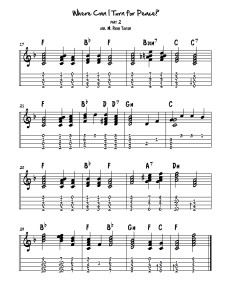 In the first part of this series I talked about some principles of chord melody arranging using the melody in the original vocal range with mostly ‘open position’ chords (the easy ones). This second part will talk about transposing the melody into standard ukulele range and using inversions of chords that are ‘up the neck.’ First you may want to print out a copy of the arrangement I’m using as an example:
In the first part of this series I talked about some principles of chord melody arranging using the melody in the original vocal range with mostly ‘open position’ chords (the easy ones). This second part will talk about transposing the melody into standard ukulele range and using inversions of chords that are ‘up the neck.’ First you may want to print out a copy of the arrangement I’m using as an example:
- Where Can I Turn for Peace (updated version with second page and added chord indications for reference purposes)
Transposing
One of the problems of arranging vocal melodies for the ukulele is that they tend to dip below the middle C that is the bottom of standard ukulele range. This is one of the main reasons there are strong supporters of low-G tuning, like James Hill (except for the Canadians it is low-A tuning). We tackled this challenge in part 1 of this series by transposing a section of the melody up an octave. Another common method of dealing with this problem is to transpose the entire melody up into ukulele range. Here are some steps that may help you with this process, using the second page of “Where Can I Turn for Peace?” as an example:
- Identify the lowest note in the melody you wish to arrange. In the example, the lowest note was an A below middle C with is a ‘minor third‘ (a whole-step plus a half-step) below the range of a standard-tuned uke. That means that in order to bring this into range we have to move all the notes up by at least a minor third.
- Bringing this melody up by a minor third would take us from the key of C (no sharps or flats) to the key of Eb (three flats). There aren’t a ton of open chords in that key, so I chose to go up another step higher to the key of F, which is a ‘perfect fourth‘ (two whole-steps plus a half-step) higher than the key of C. This key only has one flat in the key signature with a number of ‘open’ chord options.
- You’ll find the keys closest to C around the circle of fifths (learn more on wikipedia) are the easiest keys to play on the ukulele: F and G. These would be followed by D, A and Bb. These are generalizations; you might find the best key to transpose to is something odd, like Db (probably not).
- Whatever key you move to, you must make sure you move all the notes by the same interval. In this piece I’ve transposed up by a perfect fourth, so C becomes F, F becomes Bb, D becomes G, and so on.
- All of your chords need to be transposed up by the same interval; a C chord becomes an F chord, an F chord becomes a Bb chord, and so on.
- Once you have your melody and chords transposed you can begin looking for chord inversions that highlight the melody notes. You’ll be looking for notes to land on the 1st/A-string (see the first chord of measure 17) or on the 4th/G-string (see the last chord in measure 20). If the note is below these on the middle strings you can always strum a partial chord (see the first chord in measure 24).
- If you aren’t familiar with a ton of ‘up the neck’ chord inversions, cheat. Either use a ukulele chord dictionary or an online chord finder (ukebuddy.com). A reference makes it so much easier (I use one).
- If a melody note doesn’t belong to a chord (which happens often), you’ll need to add it to the chord (see the Bb on top of an F chord in measure 17 and the E on top of the Bdim7 in measure 19).
That’s about all there is to it. One of the awesome things about chord melody solos of this kind are that they force you to learn all those wonderful ‘up the neck’ chord inversions, opening all kinds of options for your playing, both instrumental and accompanimental.
Notation/tablature software (I use Finale, but there are free options like MuseScore) can help with transposing and take some of the chore out of it (of course, these have a learning curve of their own). Whatever method you use and however long it takes you to get there, there is nothing like the satisfaction of playing your own arrangement of a song.
Source Files
Get the source files (pdf, finale and music xml for import into other music editors) for the above arrangement under the ‘Files’ tab of the Joyful Noise! LDS Ukulele group on FaceBook. Also, if you’re interested in sharing your arrangements of hymns and Christ-centered spiritual songs, this is a great place to do it.
The Welti Solution : Chord Melody Arranging Part 1
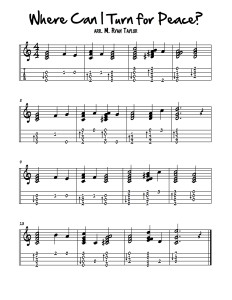 A good friend / former student asked me for some suggestions on solutions to a chord melody version of “Where Can I Turn for Peace?,” a well-known LDS hymn. He was working from the version included on page 30 of Hymns Made Easy (which includes chord indications above the melody). It was easier for me to illustrate by arranging this song than try to explain in an email, so here is my solution:
A good friend / former student asked me for some suggestions on solutions to a chord melody version of “Where Can I Turn for Peace?,” a well-known LDS hymn. He was working from the version included on page 30 of Hymns Made Easy (which includes chord indications above the melody). It was easier for me to illustrate by arranging this song than try to explain in an email, so here is my solution:
Some questions that arise in looking at this tune . . .
What do you do when some of the melody notes do not belong to the chords indicated in the music? This is a common thing in music of all stripes. Melodic notes that do not belong to the chord sequence add tension and interest to the melody. When arranging a chord melody solo you’ll need to incorporate these notes into the fingering, which means you’ll need to be able to find the note on its own in the first place (learn your C-scale to start with). For example, this hymn calls for a B-note over a C-diminished chord on in the third measure. When you change the C to a B in that chord, you end up with a B7 chord instead. You can see this in the arrangement above.
What do you do when a melody note is buried in the middle or bottom of the chord instead of being the top note? Wilfried Welti is a fairly well-known and respected ukulele arranger. I’m borrowing ‘the Welti solution’ to make this arrangement work. His answer lies in how you arpeggiate the chord you are playing. This is indicated by arrows in the arrangement that stop on the melody note you wish to highlight. An up-arrow indicates a motion from string 4 towards string 1, while a down-arrow indicates the opposite direction. You’ll note that where a melody note takes place on one of the inner strings, you stop the arpeggio on that string (see the arrangement above). Using this solution you can highlight any note of a chord.
What do you do when a melody note goes below the range of the ukulele? Lots of vocal melodies go below the C that is the lowest note on the ukulele. A popular solution is to put a low-G string on your uke, but let’s pretend that option doesn’t exist and you don’t want to string your ukulele like a mini-guitar. If we’re not willing to transpose the entire melody up into ukulele range, then we must make do somehow. One solution is to leave those notes out and to the imagination of the listener. Another is to transpose just that phrase of music up an octave. This latter option is what I’ve done at the end of the second line of music in the arrangement above.
Using these three techniques, you can create a lovely and convincing chord-melody arrangement in the ukulele’s lower range without transposing up into the higher fret-range of the instrument. I’ll talk about transposing the melody up to a ‘ukulele-friendly’ key in a future ‘part 2’ article on ukulele chord melody arranging.
Update: Now you can read part 2 on transposing! with an updated version of the arrangement.
Source Files
Get the source files (pdf, finale and music xml for import into other music editors) for the above arrangement under the ‘Files’ tab of the Joyful Noise! LDS Ukulele group on FaceBook. Also, if you’re interested in sharing your arrangements of hymns and Christ-centered spiritual songs, this is a great place to do it.
Gravity : Cover by Jason Arimoto
Rarely do you get great playing and vocals in the same solo cover . . . Just wait til he starts singing!
The Daily Ukulele : To Go!
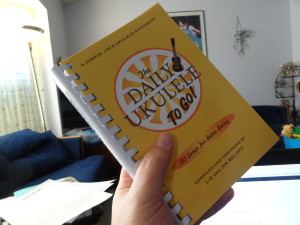 Just in case you didn’t know . . . The Daily Ukulele is now availble in a palm-sized edition. This book is awesome with a great selection of songs, is a standard at many ukulele jams, and now fits in the pocket of your ukulele case!
Just in case you didn’t know . . . The Daily Ukulele is now availble in a palm-sized edition. This book is awesome with a great selection of songs, is a standard at many ukulele jams, and now fits in the pocket of your ukulele case!
The full sized version of this is in my library, marked with about 100 post it notes. Time to start transferring my notes over. 🙂
One minor quibble I have with this, and the original book, is that many of the songs are in keys that are a little low for your average singer. However, if you learn how to transpose songs (and every player should at some point learn how to), then there is ‘no problem.’
Choosing a New Ukulele
I am often asked about choosing a new ukulele and what brand I recommend.
That’s a tough question. My advice always is to go to a store with a huge selection of instruments and try out every one they have. The brand doesn’t so much matter as one brand might have a great ukulele in one model and a hunk of wood with strings on in another. The only way to know is to try them out. Here is a list of things I would check for:
- Intonation: When you pluck an open string and then fret at the 12th fret does it sound like the same note?
- Action: Is the action good near the nut? Are the strings significantly higher off the fret board at the 12th fret? This can be adjusted, but is nice to have it right to start off with. Is the neck straight as an arrow? This can’t be adjusted.
- Tone: Do you like how the instrument sounds all the length of the neck on single notes? Does it sound crisp, balanced or muddy when you play chords? Pluck each string individually all the way up the fretboard and listen for consistency of tone and sustain. Do you note anything buzzing (buzzes may or may not be fixable)?
- Finish: As you feel along the side of the frets do they snag at your fingers or do they feel smooth and allow your fingers to run smoothly down the fret board? Again, this can be sanded down if it is ‘snaggy’ but it shows there isn’t an attention by the maker to details that are important. Check for cracks and stress marks. Do the tuners operate smoothly? Try taking it down a tone and back up again.
- Pick up / on-board electronics (if desired): Have you tested it plugged in and fiddled with any on board EQ to adjust the sound of the instrument? Do you like what your hearing? Do each of the strings pick up equally well? Do you hear ‘bassy thunks’ (this is a bad thing) every time you play an individual string? Have you tried it on a couple of different amps? Also, if you’re investing in an amp, try a few out (the amp can have a big impact on your sound).
Good looks are nice, but the above criteria are what I would look for first.
Thanks to Ian Porter and Todd Fiegel for a couple of additional thoughts that were added to the list above on finish and tone.
Learning Chords: Song by Song Vs. Step by Step
A new post on my Power Up Ukulele site that talks about the benefits of Song by Song and Step by Step learning: http://powerup.ukuleleplay.com/chords-step-by-step-vs-song-by-song-approach/
Twenty One Pilots Ukulele cover of Can’t Help Falling in Love With You
I was wondering why many of my young students were coming in and wanting to sing this classic song (originally from before I was born), but this helps explain it. This is a pretty easy one to learn using ‘level 3’ chords. Dr. Uke offers a song sheet here: http://www.doctoruke.com/canthelpfallinginlove.pdf
Exciting Development in Sustainable Ukuleles : EKoa Tenor
https://www.youtube.com/watch?v=SUbC54jlcHY
The Prettiest Ukes at NAMM 2016
These custom ukuleles by Rebel Ukulele win my award for the prettiest ukes at NAMM 2016:
Analysing a Jawaiian Strum
A student asked me to help with the strum in the body of this cover of Earth Angel:
I’ll admit I used a little known YouTube feature to help me figure out what he was doing; I slowed the video down to half speed and discovered . . . He’s combining left hand muting with chnking in a Jawaiian-style (a mixture of Hawaiian and reggae). It is really advanced, but you can conquer most anything if you break it down, go slowly and have the patience to go over it a thousand times. Here is what he is doing most of the time (with small variations throughout):
ϴ– X– ϴ– –– | ϴ– Xx ΠΦ –– (notice NOTHING is happening on beat four)
where . . .
ϴ = staccato downstroke muted quickly by lifting the left hand or with a ‘pinky mute’
X = chnk (percussive downstroke muted with rh)
x = left hand dead strum or pinky mute
Π = downstroke with index, middle or both
Φ = staccato upstroke muted quickly with right hand (or by lifting the left in case of a barre chord or by ‘pinky mute’) – in this case, either of the latter two options is used
You can simplify this by using Θ (Θ = staccato downstroke muted quickly with rh) in place of ϴ and using the right hand mute option with Φ, but it will sound subtly (or not so subtly) different, depending on many factors.
Find out more about strumming shorthand at <a href=”http://powerup.ukuleleplay.com/strumming/key-strum-shorthand/” target=”_blank”>http://powerup.ukuleleplay.com/strumming/key-strum-shorthand/</a>
Ukulele Christmas : Projector Collection
- Ukulele Christmas : Projector Collection on Teachers Pay Teachers
Some of the best tunes from The Two Chord Christmas Songbook and Christmas on 34th Street, now formatted for projectors and smartboards with group ukulele jams and classrooms in mind. Landscape formatted PDF files include . . .
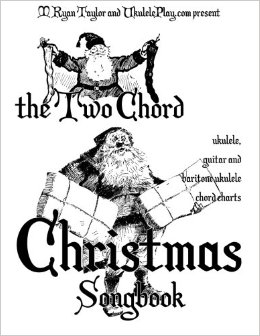 Away in a Manger
Away in a Manger
Behold that Star
Bring a Torch
Christ Was Born on Christmas Day
Christmas is Coming
Coventry Carol
Deck the Hall
Ding Dong! Merrily on High!
Go Tell it on the Mountain
Good Christian Men, Rejoice!
Good King Wenceslaus
He is Born
Here We Come A-Wassailing
Hey, Ho, Nobody Home
I Saw Three Ships
Infant Holy, Infant Lowly
Jingle Bells
Jolly Old St. Nicholas
Joy to the World
Mary Had a Baby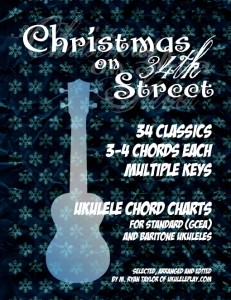
O Christmas Tree
O Little Town of Bethlehem
Oh Come All Ye Faithful
Once in Royal David’s City
Patapan
Silent Night
Sleep of the Child Jesus
Still, Still, Still
The First Noel
The Friendly Beasts
The Holly and the Ivy
Up on the Housetop
Wassail, Wassail, All Over the Town!
We Wish You a Merry Christmas
Wexford Carol
What Child is This?
What Shall We Give?
Titan M’s 2 Chord Companion : 157 songs in Ukulele-Friendly Keys
Get the 2 Chord Companion at . . .
Author’s Note:
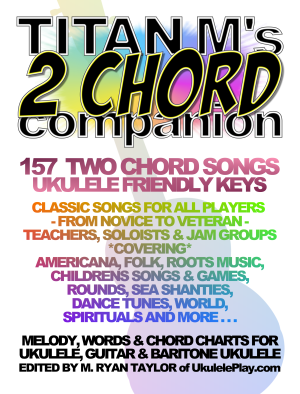 What kind of obsessive-compulsive person catalogs over 400 two-chord songs, then carefully selects the cream of the crop and painstakingly typesets 157 of them to publish in a single volume? That would be me, a self-proclaimed music nerd and ukulele enthusiast.
What kind of obsessive-compulsive person catalogs over 400 two-chord songs, then carefully selects the cream of the crop and painstakingly typesets 157 of them to publish in a single volume? That would be me, a self-proclaimed music nerd and ukulele enthusiast.
Why would I spend months doing such a thing? I spend a lot of time teaching people to play the ukulele, and two-chord songs are great for a lot of things:
- Introducing basic chord pairs
- Hammering the transition between those pairs
- Teaching chord relationships
- Training the ear to hear these relationships
- Gaining practice in transposing songs
- A feeling of accomplishment for beginners
- A jumping off point for intermediate players to begin embellishing chords
- A blank slate for advanced players to begin working on chord substitutions and arranging
- A safe place for players of all levels to jam
So, whether you’re new to the uke or a veteran player, this book is for you. I hope you’ll visit http://j.mp/UkulelePlayYouTube and subscribe to follow along as I explore many of these wonderful songs and some of the various things you can do with them.
Enjoy!
TITAN M
a.k.a. M. Ryan Taylor
Contents : By Topic
AMERICANA & HISTORICAL
Bought me a Cat
Bound for the Promised Land
Buffalo Gals
Chickalileo
Cotton Eye Joe
Darling Cory
Doodle Dandy
Down in the Valley
Freedom Train
Hymn for Nations
I’ll Sell My Hat
I’m Gonna Sing
In Wisdom’s Lovely
Pleasant Ways
Jerry
John Henry
Little Birdie
Mary Ann
No More, My Lord
Old Joe Clark
Old Stewball
Polly Wolly Doodle
Rockin’ By the Baby
Rocky Mountain
Santy Anno
Shady Grove
Shortnin’ Bread
Simple Gifts
Sinner Man
Skip to my Lou
Springfield Mountain
Streets of Laredo, The
Sweet Betsy from Pike
Tom Dooley
Train’s Off the Track
Ut Queant Laxis
Welcome Here
Wondrous Love
Yellow Rose of Texas, The
AROUND THE WORLD
Arirang
Day-O (Banana Boat Song)
Four White Horses
Land of the Silver Birch
Lukey’s Boat
Mary Ann
My Paddle’s Keen and Bright
Ode to Joy
Shalom Chaverim
She Moved Through the Fair
Shoheen Sho
Sosban Fach : Little Pot
Stewball
Sweet Molly Malone
Wild Mountain Thyme, The
LOVERS
Are Ye Sleeping Maggie?
Arirang
Black is the Color
Buffalo Gals
Clementine
Cocky Robin
Cotton Eye Joe
Darling Cory
Down in the Valley
Green Bushes
I’ll Sell My Hat
Johnny Has Gone for a Soldier
Little Birdie
Long, Long Ago
Love Somebody
Love will Find Out a Way
My Bonny Boy
My Horses Ain’t Hungry
Pretty Little Miss
Reuban and Rachel
Shady Grove
She Moved Through the Fair
Sweet Betsy from Pike
Time I’ve Lost in Wooing, The
Train’s Off the Track
Walking on the Green Grass
Water is Wide, The
Wild Mountain Thyme, The
Yellow Rose of Texas, The
CHILDREN
Ah, Poor Bird
Black Socks
Bluebird, Bluebird
Bought me a Cat
Bow Belinda
By’m Bye
Chickalileo
Cocky Robin
Down by the Station
Fair Rosa
Farmer in the Dell, The
Fire Engines
Four White Horses
Ghost of John, The
Go Tell Aunt Rhody
Grand Old Duke of York, The
I Went to the Pictures Tomorrow
I’m Gonna Sing
Itsy Bitsy Spider
I’ve Been to Harlem
I’ve Got a Car, It’s Made of Tin
Land of the Silver Birch
Little Johnny Brown
London Bridge
Love Somebody
Mactavish is Dead
Mamalama
Maria’s Gone
Mary Had a Little Lamb
More We Get Together, The
My Aunt Came Back
My Paddle’s Keen and Bright
My Zuzette
Oats and Beans
Old, Old Shack
One, Two, Three Alairy
Peter Rabbit
Poor Little Kitty Cat
Reuban and Rachel
Rosy Apple, Lemon and a Pear
Samba Lele
Skim, Skim, Skim
Skin and Bones
Sosban Fach : Little Pot
Sweet Potatoes
Telephone Song, The
Ten Little Indians
Throw it Out the Window
Where, Oh Where Has
My Little Dog Gone?
Who Did Swallow Jonah?
Who’s That?
EERIE & MORBID
Ah, Poor Bird
Are Ye Sleeping Maggie?
Bury Me Not on the Lone Prairie
Clementine
Cocky Robin
Darling Cory
Ghost of John, The
Go Tell Aunt Rhody
Jerry
Mactavish is Dead
Mary Golden Tree, The
She Moved Through the Fair
Sinner Man
Skin and Bones
Sometimes I Feel Like
a Motherless Child
Springfield Mountain
Streets of Laredo, The
Sweet Molly Malone
Three Blind Mice
Tom Dooley
Walking on the Green Grass
SPIRITUALS & HYMNS
A Poor Wayfaring Man of Grief
Bound for the Promised Land
By an’ By
Go Down Moses
Good News
He’s Got the Whole World
Hymn for Nations
I’m Gonna Sing
In Wisdom’s Lovely
Pleasant Ways
Jacob’s Ladder
Joshua Fought
the Battle of Jericho
Joyful, Joyful, We Adore Thee
Let me Fly
Mary and Martha
No More, My Lord
Nobody Knows
the Trouble I’ve Seen
Ode to Joy
Oh, Mary Don’t You Weep
Old Arks’s A-Moverin’
Palms of Victory
Rock of Ages
Rock-a My Soul
Simple Gifts
Sinner Man
Sometimes I Feel Like
a Motherless Child
Trampin’
Ut Queant Laxis
Wade in the Water
When the Train Comes Along
Wondrous Love
NONSENSE
Black Socks
Buffalo Gals
Clementine
Cotton Eye Joe
Grand Old Duke of York, The
Haul on the Bowlin’
Hurrah for the Cook
I Went to the Pictures Tomorrow
I’ll Sell My Hat
I’ve Got a Car, It’s Made of Tin
Love Somebody
Lukey’s Boat
Mary Ann
More We Get Together, The
Old Joe Clark
Old, Old Shack
One, Two, Three Alairy
Polly Wolly Doodle
Pretty Little Miss
Reuban and Rachel
Rockin’ By the Baby
Samba Lele
Shortnin’ Bread
Skip to my Lou
Sosban Fach : Little Pot
Sweet Betsy from Pike
There was an Old Fellow
Throw it Out the Window
Time I’ve Lost in Wooing, The
Who Did Swallow Jonah?
ROUNDS
Ah, Poor Bird
Down by the Station
Freedom Train
Here’s a Health
Kaeru No Uta (Frog Song)
Kookabura
List to the Bells
Little Tom Tinker
Make New Friends
My Paddle’s Keen and Bright
Oh, How Lovely is the Evening
One May Begin
Orchestra, The
Row, Row, Row Your Boat
Shalom Chaverim
Sing, Sing Together
There was an Old Fellow
Three Blind Mice
We Thank Thee for Our Daily Bread
GAMES & DANCES
Bluebird, Bluebird
Bow Belinda
Chickalileo
Cocky Robin
Fair Rosa
Farmer in the Dell, The
Four White Horses
Little Johnny Brown
London Bridge
Mamalama
Maria’s Gone
My Aunt Came Back
Old Joe Clark
One, Two, Three Alairy
Peter Rabbit
Poor Little Kitty Cat
Pretty Little Miss
Rocky Mountain
Rosy Apple, Lemon and a Pear
Samba Lele
Shady Grove
Skim, Skim, Skim
Skip to my Lou
Telephone Song, The
Walking on the Green Grass
LULLABYS
Hush Little Baby
Hushabye, Don’t You Cry
Rockin’ By the Baby
Shoheen Sho
OCEAN BLUE
Drunken Sailor
Haul on the Bowlin’
Hurrah for the Cook
I’ve Been to Harlem
John Kanaka
Lukey’s Boat
Mary Ann
Mary Golden Tree, The
Pay me my Money Down
Santy Anno
Spanish Ladies
COWBOYS
Bury Me Not on the Lone Prairie
Doney Gal
I Ride an Old Paint
My Horses Ain’t Hungry
Old Chisholm Trail, The
Railroad Corral, The
Streets of Laredo, The
256 Basic Strum Patterns!
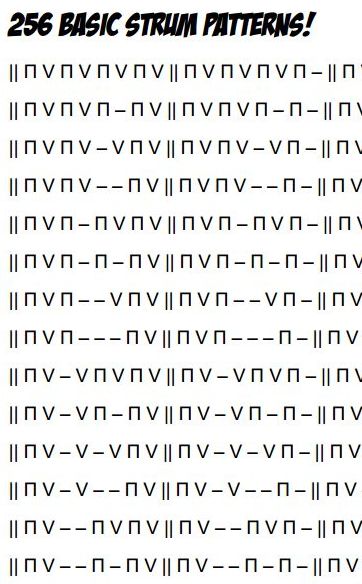 As I was working on the Level 1 Strumming section of the Power Up Ukulele site/syllabus, I got curious as to how many combinations of basic ‘down up’ strums are possible in a measure of 4/4. How useful some of these strums may or may not be is up to you to decide, but I’ve already seen a couple that might warrant a closer look.
As I was working on the Level 1 Strumming section of the Power Up Ukulele site/syllabus, I got curious as to how many combinations of basic ‘down up’ strums are possible in a measure of 4/4. How useful some of these strums may or may not be is up to you to decide, but I’ve already seen a couple that might warrant a closer look.
To get my number of 256, I limited the possibilities by removing thumb strums and assuming that upstrums will happen only on the ‘and’ or second half of a beat. That leaves us with Π V, Π –, – V & – – as possible beats (dashes represent periods where there’s silence or we’re letting the ukulele ring). I entered these into a ‘permutation calculator’ and had it generate the results. Enjoy!
|| Π V Π V Π V Π V ||
|| Π V Π V Π V Π – ||
|| Π V Π V Π V – V ||
|| Π V Π V Π V – – ||
|| Π V Π V Π – Π V || Π V Π V Π – Π – || Π V Π V Π – – V || Π V Π V Π – – – ||
|| Π V Π V – V Π V || Π V Π V – V Π – || Π V Π V – V – V || Π V Π V – V – – ||
|| Π V Π V – – Π V || Π V Π V – – Π – || Π V Π V – – – V || Π V Π V – – – – ||
|| Π V Π – Π V Π V || Π V Π – Π V Π – || Π V Π – Π V – V || Π V Π – Π V – – ||
|| Π V Π – Π – Π V || Π V Π – Π – Π – || Π V Π – Π – – V || Π V Π – Π – – – ||
|| Π V Π – – V Π V || Π V Π – – V Π – || Π V Π – – V – V || Π V Π – – V – – ||
|| Π V Π – – – Π V || Π V Π – – – Π – || Π V Π – – – – V || Π V Π – – – – – ||
|| Π V – V Π V Π V || Π V – V Π V Π – || Π V – V Π V – V || Π V – V Π V – – ||
|| Π V – V Π – Π V || Π V – V Π – Π – || Π V – V Π – – V || Π V – V Π – – – ||
|| Π V – V – V Π V || Π V – V – V Π – || Π V – V – V – V || Π V – V – V – – ||
|| Π V – V – – Π V || Π V – V – – Π – || Π V – V – – – V || Π V – V – – – – ||
|| Π V – – Π V Π V || Π V – – Π V Π – || Π V – – Π V – V || Π V – – Π V – – ||
|| Π V – – Π – Π V || Π V – – Π – Π – || Π V – – Π – – V || Π V – – Π – – – ||
|| Π V – – – V Π V || Π V – – – V Π – || Π V – – – V – V || Π V – – – V – – ||
|| Π V – – – – Π V || Π V – – – – Π – || Π V – – – – – V || Π V – – – – – – ||
|| Π – Π V Π V Π V || Π – Π V Π V Π – || Π – Π V Π V – V || Π – Π V Π V – – ||
|| Π – Π V Π – Π V || Π – Π V Π – Π – || Π – Π V Π – – V || Π – Π V Π – – – ||
|| Π – Π V – V Π V || Π – Π V – V Π – || Π – Π V – V – V || Π – Π V – V – – ||
|| Π – Π V – – Π V || Π – Π V – – Π – || Π – Π V – – – V || Π – Π V – – – – ||
|| Π – Π – Π V Π V || Π – Π – Π V Π – || Π – Π – Π V – V || Π – Π – Π V – – ||
|| Π – Π – Π – Π V || Π – Π – Π – Π – || Π – Π – Π – – V || Π – Π – Π – – – ||
|| Π – Π – – V Π V || Π – Π – – V Π – || Π – Π – – V – V || Π – Π – – V – – ||
|| Π – Π – – – Π V || Π – Π – – – Π – || Π – Π – – – – V || Π – Π – – – – –||
|| Π – – V Π V Π V || Π – – V Π V Π – || Π – – V Π V – V || Π – – V Π V – – ||
|| Π – – V Π – Π V || Π – – V Π – Π – || Π – – V Π – – V || Π – – V Π – – – ||
|| Π – – V – V Π V || Π – – V – V Π – || Π – – V – V – V || Π – – V – V – – ||
|| Π – – V – – Π V || Π – – V – – Π – || Π – – V – – – V || Π – – V – – – – ||
|| Π – – – Π V Π V || Π – – – Π V Π – || Π – – – Π V – V || Π – – – Π V – – ||
|| Π – – – Π – Π V || Π – – – Π – Π – || Π – – – Π – – V || Π – – – Π – – – ||
|| Π – – – – V Π V || Π – – – – V Π – || Π – – – – V – V || Π – – – – V – – ||
|| Π – – – – – Π V || Π – – – – – Π – || Π – – – – – – V || Π – – – – – – – ||
|| – V Π V Π V Π V || – V Π V Π V Π – || – V Π V Π V – V || – V Π V Π V – – ||
|| – V Π V Π – Π V || – V Π V Π – Π – || – V Π V Π – – V || – V Π V Π – – – ||
|| – V Π V – V Π V || – V Π V – V Π – || – V Π V – V – V || – V Π V – V – – ||
|| – V Π V – – Π V || – V Π V – – Π – || – V Π V – – – V || – V Π V – – – – ||
|| – V Π – Π V Π V || – V Π – Π V Π – || – V Π – Π V – V || – V Π – Π V – – ||
|| – V Π – Π – Π V || – V Π – Π – Π – || – V Π – Π – – V || – V Π – Π – – – ||
|| – V Π – – V Π V || – V Π – – V Π – || – V Π – – V – V || – V Π – – V – – ||
|| – V Π – – – Π V || – V Π – – – Π – || – V Π – – – – V || – V Π – – – – – ||
|| – V – V Π V Π V || – V – V Π V Π – || – V – V Π V – V || – V – V Π V – – ||
|| – V – V Π – Π V || – V – V Π – Π – || – V – V Π – – V || – V – V Π – – – ||
|| – V – V – V Π V || – V – V – V Π – || – V – V – V – V || – V – V – V – – ||
|| – V – V – – Π V || – V – V – – Π – || – V – V – – – V || – V – V – – – – ||
|| – V – – Π V Π V || – V – – Π V Π – || – V – – Π V – V || – V – – Π V – – ||
|| – V – – Π – Π V || – V – – Π – Π – || – V – – Π – – V || – V – – Π – – – ||
|| – V – – – V Π V || – V – – – V Π – || – V – – – V – V || – V – – – V – – ||
|| – V – – – – Π V || – V – – – – Π – || – V – – – – – V || – V – – – – – – ||
|| – – Π V Π V Π V || – – Π V Π V Π – || – – Π V Π V – V || – – Π V Π V – – ||
|| – – Π V Π – Π V || – – Π V Π – Π – || – – Π V Π – – V || – – Π V Π – – – ||
|| – – Π V – V Π V || – – Π V – V Π – || – – Π V – V – V || – – Π V – V – – ||
|| – – Π V – – Π V || – – Π V – – Π – || – – Π V – – – V || – – Π V – – – – ||
|| – – Π – Π V Π V || – – Π – Π V Π – || – – Π – Π V – V || – – Π – Π V – – ||
|| – – Π – Π – Π V || – – Π – Π – Π – || – – Π – Π – – V || – – Π – Π – – – ||
|| – – Π – – V Π V || – – Π – – V Π – || – – Π – – V – V || – – Π – – V – – ||
|| – – Π – – – Π V || – – Π – – – Π – || – – Π – – – – V || – – Π – – – – – ||
|| – – – V Π V Π V || – – – V Π V Π – || – – – V Π V – V || – – – V Π V – – ||
|| – – – V Π – Π V || – – – V Π – Π – || – – – V Π – – V || – – – V Π – – – ||
|| – – – V – V Π V || – – – V – V Π – || – – – V – V – V || – – – V – V – – ||
|| – – – V – – Π V || – – – V – – Π – || – – – V – – – V || – – – V – – – – ||
|| – – – – Π V Π V || – – – – Π V Π – || – – – – Π V – V || – – – – Π V – – ||
|| – – – – Π – Π V || – – – – Π – Π – || – – – – Π – – V || – – – – Π – – – ||
|| – – – – – V Π V || – – – – – V Π – || – – – – – V – V || – – – – – V – – ||
|| – – – – – – Π V || – – – – – – Π – || – – – – – – – V || – – – – – – – – ||
Christmas Carols for Ukulele Orchesta now on Amazon
AND . . . it is already the #1 bestseller in New Releases for Ukulele Songbooks, and I haven’t even started promoting it. Check out Christmas Carols for Ukulele Orchestra on Amazon and be the first to leave a review!
More new demos for The Haunted Ukulele
I recorded 5 more demos yesterday for my new book, The Haunted Ukulele:
- Halloween Carnival (an original!)
- The Haunted House (by Irving Berlin!)
- The Happy Cow Song (another original!)
- Hangman (my parody for kids on Tom Dooley)
- Old Roger (a circle game for kids from Great Britain)
Enjoy the entire Haunted Ukulele Playlist:
https://www.youtube.com/watch?v=W1t1yuVOyhs&list=PLa626nR993OwrlUuS_ssyWl5mYsp8DTyH
6 New Haunted Ukulele Demo Videos
I finished 6 new demo videos for The Haunted Ukulele today (for a total of 39 of the 59 songs in the book):
I’ve added these to the playlist:
http://youtu.be/W1t1yuVOyhs?list=PLa626nR993OwrlUuS_ssyWl5mYsp8DTyH
Chopsticks Tab for Ukulele
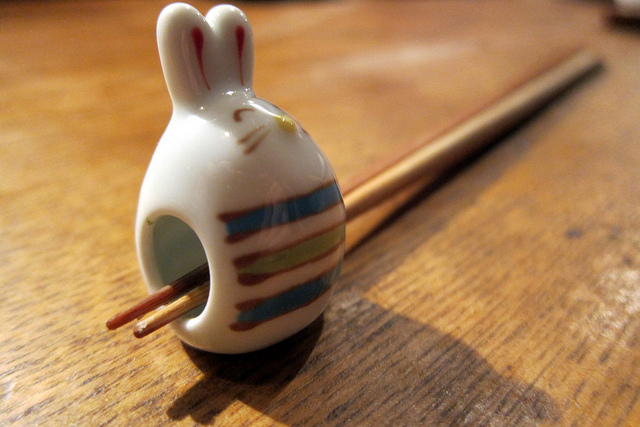 I was noodling around on my uke a few weeks ago when something started to sound familiar, “That’s Chopsticks.” So I took a few minutes and figured out the rest of the piece. The A-section is really easy and the B-section is a really great exercise for various double-stops (which I’ve included 2 different ways).
I was noodling around on my uke a few weeks ago when something started to sound familiar, “That’s Chopsticks.” So I took a few minutes and figured out the rest of the piece. The A-section is really easy and the B-section is a really great exercise for various double-stops (which I’ve included 2 different ways).
So here you go, the celebrated chopstick waltz:
- Chopsticks (PDF)
Enjoy!



